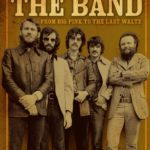There is no shortage of thoughtful writing about The Band. From the beginning, the archetypical roots-rock ensemble has been catnip to journalists. Barney Hoskyns, Greil Marcus and dozens of others have celebrated The Band’s poetry (soulful vocals; aching lyrics; Delta blues) as well as its paradoxes (rough-hewn yet polished; simple yet grandiose; decidedly American yet germinated largely on Yonge Street in Toronto). A Time magazine cover story in 1970 declared that “five musical Huck Finns” had “emerged as the one group whose sheer fascination and musical skill may match the excellence–though not the international impact–of the Beatles.” Add to the mix the band members’ own narratives–Levon Helm’s no-nonsense This Wheel’s on Fire (with co-author Stephen Davis, 1993) and Robbie Robertson’s contemplative Testimony (2016)–and one could be forgiven for concluding that there was nothing more to tell.
The Last Waltz may have been in 1976, but the party isn’t over. And the latest narrative to emerge, by veteran music writer Harvey Kubernick and his brother Ken Kubernick, suggests that the story of The Band may be best told in the form of a scrapbook, pulling together interview snippets, article blurbs, pithy quotations and a great many photos. We traverse the familiar chronology: first stirrings as The Hawks; discovery by Bob Dylan; formative retreat in the Hudson Valley; touring, with and without Dylan; escape to Malibu; complications; goodbyes at the Winterland Ballroom. But we also pause in key moments to soak up context. An early section on Elvis Presley, for example, underscores the band’s rockabilly roots. A digressive note on winter seclusion in the Hudson Valley suggests that the hymn-like qualities that propel Music From Big Pink may have something to do with the region’s abundant bars and churches–places to sin and places to be redeemed. Occasional sidebars on equipment and stage setup, details other accounts might choose to omit, hint at the careful engineering of The Band’s “multilayered, artisanal sound.”
We are presented with a vast assemblage of photos, carefully curated to highlight The Band at their best: posing before lush Catskill Mountain vistas; sharing a stage microphone at Woodstock; belting it out on a tour bus with Janis Joplin. Robbie jamming guitar-to-guitar with Dylan. Levon, gruff and grinning behind his kit. The guys draped over recording studios and sunglassed on stage. Some photos, such as those shot for the Time cover but left unused, have remained unavailable until now. Other artifacts round out the scrapbook aesthetic: ticket stubs; programs; a jaw-dropping 1974 setlist in which the entry “BOB – ACOUSTIC” is casually hand-annotated with the phrase “Times – changing”.
What we don’t see is dirt. Unsavory moments emphasized by other authors–substance abuse, depression–are glossed. The internecine feuding between band members is acknowledged but quickly forgiven as the Kubernick brothers emphasize positive, harmonious aspects of The Band’s history. It helps that their narrative ends with The Last Waltz; leaving the inevitable fragmentation, and the worst tragedies, largely offstage.
The multitude of voices, including quotes from the band members and tour crew, journalists and fellow musical luminaries, gives The Story of The Band a certain broad-spectrum authority about its subject, as well as a bit of a documentary-film vibe. A spread on Woodstock, for example, serves up, on a single jam-packed page, overlapping commentary from Jerry Garcia, Graham Nash, and producer-engineer Richard Bosworth. But if the sheer volume of quotes and commentators at times risks cacophony, mostly the conversation feels fluid and organic, like the guys trading off verses as they build to a rousing chorus.
Is this a coffee table book? Absolutely. Nostalgia piece? No doubt. But above all this richly appointed, polyphonic work is all about the music it celebrates. In this respect the Kubernick brothers have faithfully reflected the spirit of The Band itself. The fans will appreciate it.



No Comments comments associated with this post